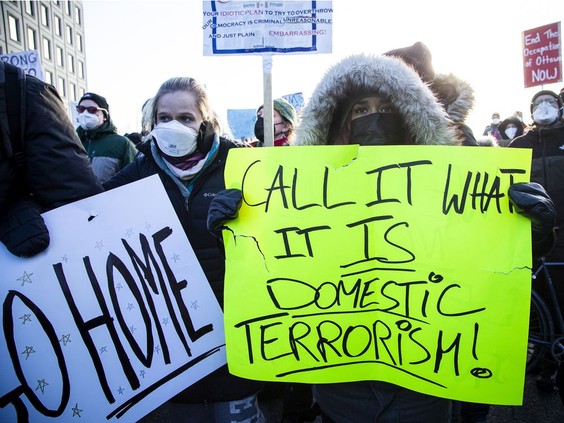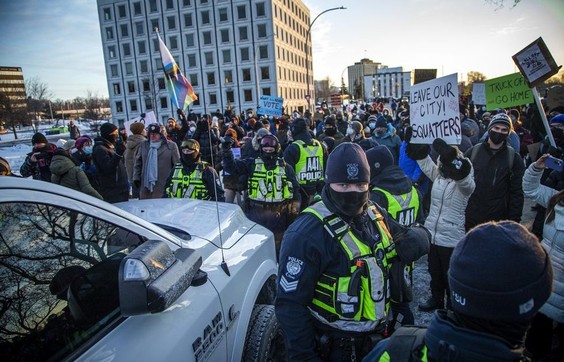'Battle of Billings Bridge' attracts hundreds of volunteers, traps convoy for hours | Ottawa Citizen
"It just happened. I have never seen anything like it."
Author of the article:
Joanne Laucius
Publishing date:
Feb 15, 2022 • 20 hours ago • 4 minute read • 24 Comments

Counter-protesters set up a blockade on Riverside Drive at Bank Street on Sunday, Feb. 13, 2022. PHOTO BY ASHLEY FRASER /Postmedia
Shortly after 10 p.m. on Saturday night, Sean Burges made a suggestion that spread like wildfire.
Burges, a senior instructor in global and international study at Carleton University, had learned that a convoy of trucks would be travelling on Riverside Drive on Sunday morning, heading west to Bronson Avenue, where the trucks would turn north and join protesters downtown.
Burges’ plan was posted on a neighbourhood Facebook page usually dedicated to arranging playdates and dog walking: a group of volunteers would block the corner of Bank Street and Riverside Drive, detaining the convoy for a short time. Just long enough to make a point: You are disrupting the lives of people in Ottawa. Please stop.
On Sunday morning at 9 a.m, about two dozen people were at the intersection.
“I just hopped on board,” said Andrea Harden. “Some people had markers and posterboard. There was some talk about whether we should bring a hockey net to block the intersection.”
They didn’t use the hockey net. There were enough volunteers to corral about 35 vehicles in the convoy, mostly pickup trucks. Local traffic was waved through.
Police arrived within minutes. Dozens more volunteers showed up, then hundreds, relieving those who were getting cold or needed a break.
Minutes turned to hours. They chanted and marched around in circles to keep warm. Supporters brought so much pizza, coffee and doughnuts that the surplus was diverted to a shelter downtown.

Counter-protesters set up a blockade on Riverside Drive at Bank Street on Sunday, Feb. 13, 2022. PHOTO BY ASHLEY FRASER /Postmedia
“People were organically engaging where we needed them,” said Harden, who has training in de-escalation techniques and non-violent civil disobedience. “It just happened. I have never seen anything like it.”
Decisions were made by consensus. As the hours rolled by, “discussion circles” were held to decide the conditions for releasing the trucks. No one wanted the trucks to be able to turn around and go downtown using some other route, or to head back to the supply base on Coventry Road, said Harden.
As the sun was going down and the temperatures dipped, the truck drivers in the convoy were permitted a “negotiated retreat” — they were allowed to leave one at a time, but only after their trucks had been stripped of flags, and “Freedom Convoy” stickers, and surrendered any jerry cans.
“The look on their faces when they were taking down their flags was one of defeat, not of pride,” said Harden.
Sean Devine went to the blockade with the intent of speaking to as many people in the convoy as possible.
“I don’t want to take away anyone’s right to protest, but I wanted them to hear that they’re having a negative impact on the citizens of Ottawa,” said Devine, who said about two-thirds of drivers in the convoy agreed to talk.
“Most of the people I spoke to were surprised at the resistance. I think the convoy is under the false impression that they have unwavering popular support. It helps them to see opposition.”
Ariel Troster, who intends to run for council in Somerset ward, said Centretown residents are living in an atmosphere of fear.
“It felt good to take back some of the power,” she said. “We’re not advocating for rubber bullets and tear gas. We just want our city back. It’s going to take citizens to block major thoroughfares, then it’s going to happen.”

Counter-protesters set up a blockade on Riverside Drive at Bank Street on Sunday, Feb. 13, 2022. PHOTO BY ASHLEY FRASER /Postmedia
By the time the blockade was over about nine hours after it began, those who were part of what some have dubbed “the Battle of Billings Bridge” were declaring victory.
Capital ward Coun. Shawn Menard, who was at the blockade all day, estimated that more than 1,000 people attended. “Organically, we were 1,000 people standing shoulder to shoulder,” he said.
There were some tense moments. The driver of one truck was attempting to nudge people out of the way with his vehicle, said Ottawa Centre MPP Joel Harden, who was on the scene and looking on with mixed feelings of pride and anxiety.
The question for many now is whether this action will be replicated. James Hutt, a member of Community Solidarity Ottawa, said the group plans to post information about future rallies though its website and social media channels.
But the circumstances may never be the same again.
“I would definitely do it again,” said Gillian Carter, who was one of the first to join the blockade. “It was so organic. It was galvanizing for the community. But I don’t know if you can create that organic feeling again.”
Safety is a big concern. Citizens should not be thrust into the situation of being law enforcement, Harden said. “I just want people to think about safety.”
Burges concedes that things could gave gone horribly wrong on Sunday. But there is a lot of frustration over the ineffectiveness of enforcement so far. In Ottawa, there is a deep pool of experience in areas such as negotiations and protest organizing, he said.
“We could seal (the protesters) in. We could create a human chain and close it if police won’t,” said Burges.
"It just happened. I have never seen anything like it."
Author of the article:
Joanne Laucius
Publishing date:
Feb 15, 2022 • 20 hours ago • 4 minute read • 24 Comments

Counter-protesters set up a blockade on Riverside Drive at Bank Street on Sunday, Feb. 13, 2022. PHOTO BY ASHLEY FRASER /Postmedia
Shortly after 10 p.m. on Saturday night, Sean Burges made a suggestion that spread like wildfire.
Burges, a senior instructor in global and international study at Carleton University, had learned that a convoy of trucks would be travelling on Riverside Drive on Sunday morning, heading west to Bronson Avenue, where the trucks would turn north and join protesters downtown.
Burges’ plan was posted on a neighbourhood Facebook page usually dedicated to arranging playdates and dog walking: a group of volunteers would block the corner of Bank Street and Riverside Drive, detaining the convoy for a short time. Just long enough to make a point: You are disrupting the lives of people in Ottawa. Please stop.
On Sunday morning at 9 a.m, about two dozen people were at the intersection.
“I just hopped on board,” said Andrea Harden. “Some people had markers and posterboard. There was some talk about whether we should bring a hockey net to block the intersection.”
They didn’t use the hockey net. There were enough volunteers to corral about 35 vehicles in the convoy, mostly pickup trucks. Local traffic was waved through.
Police arrived within minutes. Dozens more volunteers showed up, then hundreds, relieving those who were getting cold or needed a break.
Minutes turned to hours. They chanted and marched around in circles to keep warm. Supporters brought so much pizza, coffee and doughnuts that the surplus was diverted to a shelter downtown.

Counter-protesters set up a blockade on Riverside Drive at Bank Street on Sunday, Feb. 13, 2022. PHOTO BY ASHLEY FRASER /Postmedia
“People were organically engaging where we needed them,” said Harden, who has training in de-escalation techniques and non-violent civil disobedience. “It just happened. I have never seen anything like it.”
Decisions were made by consensus. As the hours rolled by, “discussion circles” were held to decide the conditions for releasing the trucks. No one wanted the trucks to be able to turn around and go downtown using some other route, or to head back to the supply base on Coventry Road, said Harden.
As the sun was going down and the temperatures dipped, the truck drivers in the convoy were permitted a “negotiated retreat” — they were allowed to leave one at a time, but only after their trucks had been stripped of flags, and “Freedom Convoy” stickers, and surrendered any jerry cans.
“The look on their faces when they were taking down their flags was one of defeat, not of pride,” said Harden.
Sean Devine went to the blockade with the intent of speaking to as many people in the convoy as possible.
“I don’t want to take away anyone’s right to protest, but I wanted them to hear that they’re having a negative impact on the citizens of Ottawa,” said Devine, who said about two-thirds of drivers in the convoy agreed to talk.
“Most of the people I spoke to were surprised at the resistance. I think the convoy is under the false impression that they have unwavering popular support. It helps them to see opposition.”
Ariel Troster, who intends to run for council in Somerset ward, said Centretown residents are living in an atmosphere of fear.
“It felt good to take back some of the power,” she said. “We’re not advocating for rubber bullets and tear gas. We just want our city back. It’s going to take citizens to block major thoroughfares, then it’s going to happen.”

Counter-protesters set up a blockade on Riverside Drive at Bank Street on Sunday, Feb. 13, 2022. PHOTO BY ASHLEY FRASER /Postmedia
By the time the blockade was over about nine hours after it began, those who were part of what some have dubbed “the Battle of Billings Bridge” were declaring victory.
Capital ward Coun. Shawn Menard, who was at the blockade all day, estimated that more than 1,000 people attended. “Organically, we were 1,000 people standing shoulder to shoulder,” he said.
There were some tense moments. The driver of one truck was attempting to nudge people out of the way with his vehicle, said Ottawa Centre MPP Joel Harden, who was on the scene and looking on with mixed feelings of pride and anxiety.
The question for many now is whether this action will be replicated. James Hutt, a member of Community Solidarity Ottawa, said the group plans to post information about future rallies though its website and social media channels.
But the circumstances may never be the same again.
“I would definitely do it again,” said Gillian Carter, who was one of the first to join the blockade. “It was so organic. It was galvanizing for the community. But I don’t know if you can create that organic feeling again.”
Safety is a big concern. Citizens should not be thrust into the situation of being law enforcement, Harden said. “I just want people to think about safety.”
Burges concedes that things could gave gone horribly wrong on Sunday. But there is a lot of frustration over the ineffectiveness of enforcement so far. In Ottawa, there is a deep pool of experience in areas such as negotiations and protest organizing, he said.
“We could seal (the protesters) in. We could create a human chain and close it if police won’t,” said Burges.